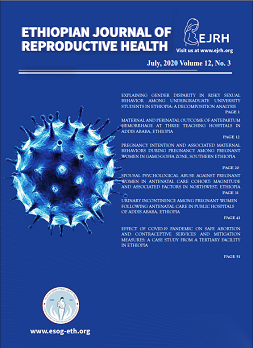Urinary Incontinence Prevalence during Pregnancy: the Ethiopian perspective
DOI:
https://doi.org/10.69614/ejrh.v12i3.389Keywords:
Lower urinary tract symptoms, Pregnancy, ICI, the Leister Urinary Symptom Questionnaire, Addis Ababa, EthiopiaAbstract
ABSTRACT
Urinary incontinence (UI) is a common but under-reported problem among women globally. Information on the prevalence and health burden of UI in Ethiopia is unknown. Measuring the prevalence of these symptoms has been difficult because of lack of uniform nomenclature and standardized tool. This study aimed to establish the prevalence of urinary incontinence and its determinants among pregnant women in Addis Ababa, Ethiopia.
This was a cross-sectional study in which the International Consultation on Incontinence criteria qualified Questionnaire was administered in July 2015, to 333 consenting pregnant women aged 15 to 42 years who were attending Antenatal care at, tertiary Hospitals, in Addis Ababa, Ethiopia.
Of the three hundred thirty three pregnant women 82(24.6%) reported Urinary Incontinence. Thirty eight (11.4%) reported stress urinary incontinence only, 15(4.5%) reported urge incontinence only and 29(8.7%) reported mixed incontinence during the preceding month (8% had moderate or severe symptoms). Sixty nine percent of these had not consulted a health care professional. The determining factor for prevalence of UI was the mode of delivery. Of the pregnant women who practiced C/S the prevalence of UI was lower than those women whose mode of delivery was vaginal (AOR: 0.46:95%CI (0.22, 0.98).
This study showed that many pregnant women in Ethiopia suffer in silence from a variety of lower urinary tract symptoms. There is need to create awareness among women with symptoms as nearly two third (64%) of those with daily episodes of urinary incontinence do not seek help. Health care providers must build their capacity to recognize, investigate and manage lower urinary tract morbidities in pregnancy
Keywords: Lower urinary tract symptoms, Pregnancy, ICI, the Leister Urinary Symptom Questionnaire, Addis Ababa, Ethiopia
References
1. Stian Langeland Wesnes SHaG. Epidemiology of Urinary Incontinence in Pregnancy and Postpartum. Department of Public Health and Primary Health Care Department of Public Health and Primary Health Care.
2. Chan SS1 CR, Yiu KW, Lee LL, Chung TK. Prevalence of urinary and fecal incontinence in Chinese women during and after their first pregnancy. Int Urogynecol J. 2013;Int Urogynecol J.
3. Abrams P CL, Fall M, Griffiths D, Rosier P, Ulmstein U. The standardization of terminology of lower urinary tract function; report from the standardization sub-committee of the international continence society. NeurourolUrodyn. 2002;21:167–178.
4. Adaji SE1 SO, Bature SB, Nasir S, Olatunji O. Bothersome lower urinary symptoms during pregnancy: a preliminary study using the International Consultation on Incontinence Questionnaire. Afr Health Sci 2011; Suppl 1:S46-52.
5. StianLangelandWesnes. Urinary Incontinence and Weight Change During Pregnancy and Postpartum: A Cohort Study. American Journal of Epidemiology 2010;ISB N:978-953-51-0484-1,In
6. Fitzgerald MP GS. Anatomical and functional changes of the lower urinary tract during pregnancy. Urologic Clinics of North America. 2007;34:7–12.
7. Chaliha C SS. Urological problems in pregnancy. BJU Int 2001;89:469–476.
8. Women's lower urinary tract function and dysfunction: definitions and epidemiology. Minerva Ginecol 2004;56:311–325.
9. Malpas P JT, Lister UM. Displacement of the bladder and urethra in late pregnancy. J Obstet Br Emp. 1949;1949;56:949–960.
10. Mikhail MS A. A. Lower urinary tract dysfunction in pregnancy: a review. ObstetGynecolSurv. 1995;50:675–683.
11. J P Madombwe SK. High prevalence of urinary incontinence and poor knowledge of pelvic floor exercises among women in Ladysmith.School of Family Medicine and Public Health, Nelson R Mandela School of Medicine, University of KwaZulu-Natal, Durban. . SAJOG. February; 2010, Vol. 16, No. 1.
12. Uptodate. Guidelines for Adult Urinary Incontinence Collaborative Consensus Document for the Canadian Urological Association
2012.
13. 3rd International Consultation on Incontinence: Recommendations of the international scientific committee. ICI. 2005;V 1, Page 1589-1630.
14. Mommsen AFS. Prevalenceof Urinary Incontinence as a correlate of pregnancy, vaginal childbirth and obstetric techniques. American Journal of Public Health 1996;Vol.89. page 209-212.
15. Ojengbede M. Prevalence and the associated trigger factors of urinary incontinence among 5000 black women in sub-Saharan Africa: findings from a community survey. BJU Int. 2011.



